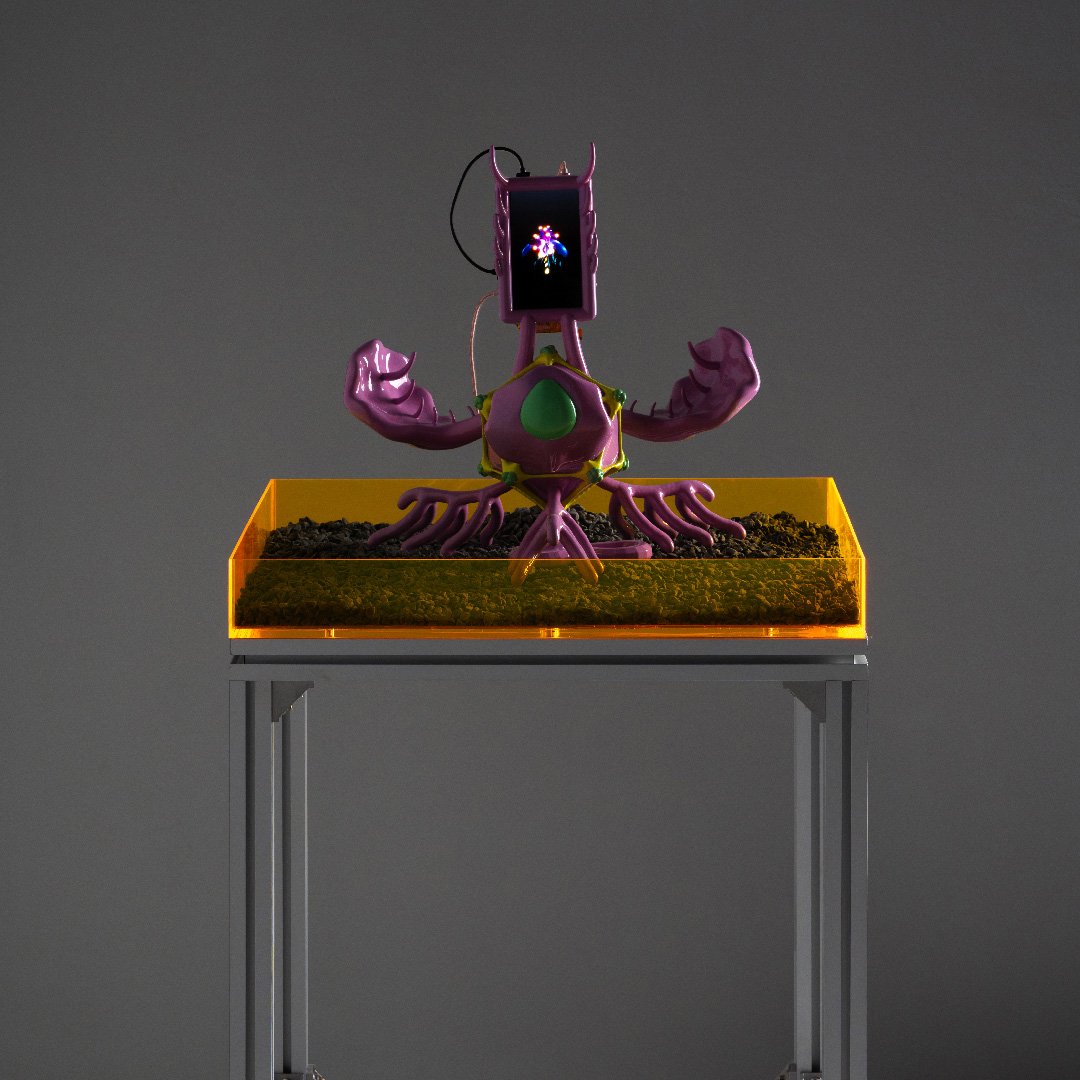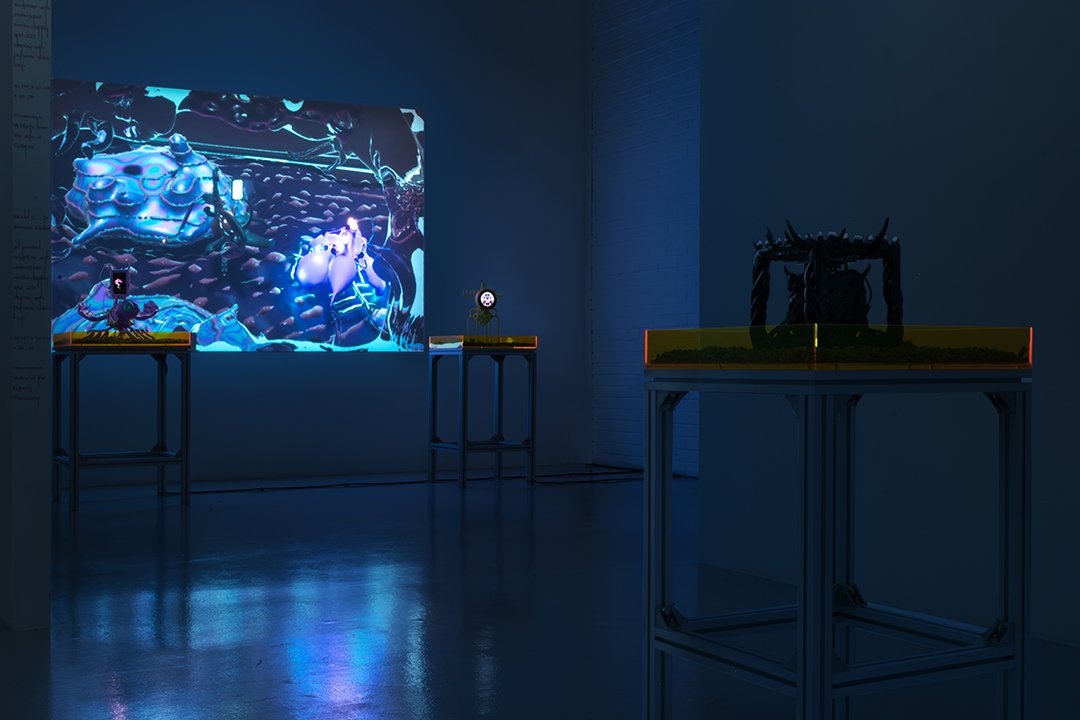Brandon Tay
Brandon Tay is a Singaporean artist whose work explores emergent complexities in digital materials. Starting out as a prominent figure in Singapore's underground audio-visual scene, he has more recently expanded his practice into one that engages with varying permutations of projection mapping, digital, computer-generated imagery (CGI), time-based and new media, game environment art.
The intersection of digital art with 3D sculptures and digital constructs brings a new realm where immersive simulations expand the boundaries between the material and virtual worlds. This interview focuses on the practice of Singaporean artist Brandon Tay, whose works epitomize this innovative fusion, redefining traditional boundaries of art. A closer look is taken at incorporating digital art in the artist's practice and the profound implications of his latest solo show, "Form and Agency." The exhibition highlights the artist's intricate use of "models" to speculate on alternate worlds and histories. Additionally, machinic animism is explored, an approach that diverges from conventional discourses on artificial intelligence (AI). Rather than anthropomorphizing AI, the artist seeks to foster a deeper understanding of AI in its non-human terms, challenging anthropocentric views and paving the way for a potential hybrid consciousness that merges human and AI intelligence.
Through this exploration, the intricacies of digital art are unveiled, shedding light on how this medium not only encapsulates the present but also speculates on the myriad possibilities the future holds.
Your digital artwork has a corporeal presence where 3D sculptures interact with digital constructs in immersive simulations and expand the limits of the inevitable interaction between what we conceive of as the material and the virtual. It would be interesting for you to tell us about how digital art entered your practice.
I came of age around the turn of the millennium. I was part of the generation that was the last to experience the world without the internet, the same way that the generation now is the latest to experience culture without the influence of AI. Part of being a teenager then was a kind of idealism about technology, and the future that I feel might not be so common today. Naturally, being around computers and the web at the time piqued my interest in the nascent potential of animation, computer graphics, and gaming, etc. I got into the work of William S Burroughs, William Gibson, and JG Ballard at the time, too, which remain a crucial influence. This confluence of a fictitious ideal of digital spaces and the reality of it manifesting is a tension that I've come to be fascinated by and what I explore in my work.
The works in your latest solo show, "Form and Agency," are different attempts at world-building. Can you tell us more about your use of "models" to speculate worlds and their histories?
The term model can suggest a couple of things: a model as a physical representation of a building or territory, a conceptual framework that rationalizes hypothetical scenarios, or, in an AI context, a program or algorithm that relies on training data to recognize patterns and make predictions or decisions. The worldbuilding process encompasses all these disparate interpretations and hints at what these sculptures represent.
On your website, you refer to a work titled “One or Several Agents: Machinic Animism 01." Animism is usually understood in the context of indigenous spirituality and shifting away from an anthropocentric approach to the world and nature. Most discourses around AI focus on the ethical and scientific aspects of AI and approximate it to human intelligence. I wonder how machinic animism could be a move away from that approach. Could you please reflect on your understanding of machinic animism?
There's a great description of what animism is from the anthropologist Eduardo Viveiros De Castros, where he describes his interpretation of animism as being that modern myths present humans as distinct from nature, our culture, and souls, elevating us above animals and objects. But indigenous myths see humans as initially the same as animals, our shared souls connecting us to the world. Animism views the soul as our unity with nature and the body as our distinction. Applying this to contemporary concerns surrounding AI, rather than only evaluating AI by how closely it mimics human behaviour, we could take a more generative approach of seeking to understand AI in its non-human terms. Let's open our minds to perceiving the world through an AI's unique computational mode of thinking. We may discover novel insights that emerge from engaging with its alternative material perspective. Instead of imposing our anthropocentric expectations onto AI, we could pursue a more Deleuzian style of reciprocal "becoming" - allowing ourselves to be affected by the AI's alien logic and evolving our intelligence through this symbiotic relationship. By embracing the AI's inhuman distinctions, we can expand our modes of thought and potentially achieve new states of hybrid consciousness by merging with a fundamentally different form of material cognition. The goal is not just humanizing the AI but allowing the AI to dehumanize and deterritorialize us as we think together. The term Machinic Animism exists as a placeholder for these ideas and approaches as they evolve.
Model A of Form and Agency, "Adversaries," "[p]roposes a world in which biological computation has replaced silicon-based devices. [...]It was created primarily from four anthropomorphic lab-grown homunculi with a common spinal cord and nervous system, which served as an engine for opposing and symmetrical desire drives. From a central orifice, a polymorphic computational fluid was secreted as a matrix to regulate the intermediate flows and interactions."
Your approach to materiality is significant in the way it allows for speculated realities to have a life of their own. It expands the limits of the imaginary and will enable it to exist parallel to what we know as "the present."
The work intends to embody forces that run through an imagined "biological computer," and is described as a relic from an imagined future vision materializing in real-time; it's described as a failed experiment, one attempt at moving away from generative AI to biological computation, but as all failed experiments this piece has history and a life of its own. It is an ongoing successful attempt at thought-provoking and engaging many contemporary questions and urgent anxieties concerning what machines can become and do.
What interests me the most about the work is the link to the wiki (a fandom page), which anticipates the Model's lore in a way that is self-mythologizing; it gives it a persona, it could be a failed attempt at creating a biological compute but succeeds at mechanic animism.
Can you tell us more about this work and what you imagine biological computation to be? What are your thoughts on libidinal flows, intellectual/spiritual, in general, and specifically in the context of networks and online existence?
The portal for this world opened up from learning about the processes of generative adversarial networks, a now outdated form of machine learning overtaken by recent developments in diffusion-based algorithms. In generative adversarial networks (GANs), we encounter terms like generators, discriminators, adversaries, and hidden layers, which, for me, evoked a sense that these parameters operated a bit like parts of a body, elements of a bureaucracy and even modes of communication. Expanding these ideas into a world and figuring out what speculative technologies would work in this context, which hinted at the complexity of its implications, was the next step.
Tonally, the vibe that resonated with me about how this world functioned was similar to the work of the brothers Strugatsky, who wrote the novel Roadside Picnic, which eventually became the Andrei Tarkovsky film Stalker. That mood of outmoded tech (GANs) in our world, eventually becoming failed experiments, was similar to what I felt the authors of that work were envisioning with the relics of the Zone. One space in which the logic of the world of Adversaries had a gap was to try and imagine the force that animates the technology of this world.
I recalled the research of the psychologist William Reich, who proposed that Orgone, the energetic expression of the libido, was something that could be harnessed and utilized; using this pseudo-scientific concept in this biologically centred, libidinously networked world seemed apt. The lines of flight, the thought swarms surrounding this model, came from these kernels.
In the world of Adversaries, technologies are born, age, and die in a more visceral way than ours, constantly deterritorializing and re-territorializing with failed relics still functioning in a zombified half-life. The seed from which this model proposes feels like something that I want to continue either as some form of choreography, a film, or maybe even, like in the case of Stalker, a video game of some description.
In Stalker, the “Room” functions as a space that both invites and denies all of these failed mystical relics to mediate desire and the journey to it; how does the space of the gallery function for your art?
The gallery functions primarily in the context of this exhibition as a kind of psychic excavation site, a place to unearth anomalous objects and mysterious material. In another sense, it can operate like the latent spaces that AI navigates through: zones of potentiality that we cannot access in totality but only from an oblique angle. It also forces me to condense these potentialities into token-length prompts for a viewer to be able to access. The wiki, on the other hand, operates best as a place of constant evolution, revision, and contestation, available to anyone with an interest and an account, not unlike an earlier version of the internet with a more utopian ideal. The gallery is the narrow entry point; the digital space reveals the facets of the hyper object that we can interact with on a deeper conceptual level than just haptic responses or the mirroring so familiar with new media art.
Your relics turn the inside-out, speculative digital matter into a sculpture that holds screens that open the space into other planes of experience: the stream-of-consciousness hallucinations of Model E: Nomad Lexis, the encrypted occulted data world of Model C: Marrow Codex, and the inner religious life of Model B: Orchid Mantis. With the hegemony of Web2, our use of screens and what we see on them has become limited; your show expands the limitations of what screens can be. Could you reflect on the use of screens in your work and what has changed since the image became digital?
The primary influence for the presentation and incorporation of screens as part of the sculptures came from looking at Catholic reliquaries and religious objects. In a certain sense, they can be viewed as containers for the soul, hinting at the inner worlds of where these objects come from. There’s also an element of dimensionality that I want to communicate with them as well, something best exemplified with Adversaries. First, we have the physical substrate of the 3D printed sculpture, then its two-dimensional counterpart, and then finally, the spectre of their interfacing, as demonstrated by the Pepper’s Ghost effect on the dome. What I wanted to convey was something that couldn’t be contained necessarily in one form or medium, that it had to be captured in various mediums to grasp something more significant and immaterial.
For me, there seem to be two tangents regarding screens: one moving towards total fidelity, monumentality, and a never-ending progression towards more computing power and an exacting replication of reality, whatever that might mean, and another towards ubiquity, abstraction, and poor images, exemplified by endlessly reposted and recompressed videos and the syntax of emojis that we see on smaller and smaller screens. One approach attempts the impossible by trying to simulate every fragment of the waking world, while the other obfuscates by deteriorating the image and encrypting language into a pictographic code. I think where it becomes interesting is how to navigate through these sentiments in contradictory ways.
interview by DANA DAWUD
What to read next














